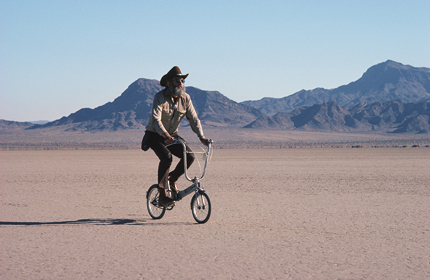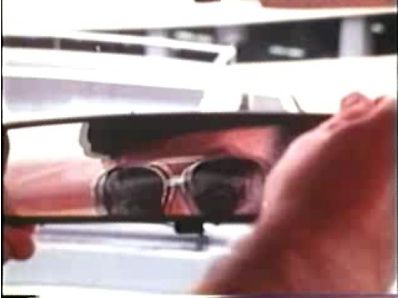
Reyner Banham, the Silurian Lake south of Death Valley in San Bernardino County, California. Photo: Tim Street-Porter. Via archpaper.com.
Reyner Banham, the British architectural historian whose blatant enthusiasm for Los Angeles nearly got him blacklisted in an era in which the cultured loved to hate this city, revered crisps, those small potato-based chip-like products that had gone from English bar fare to brightly packaged supermarket snack stuff. Banham, speaking tongue-in-cheek, called them a “triumph of progressive technology,” and, explaining away their utter lack of food value, wondered if they might be the “nutriment of angels rather than mortal flesh.”
It’s this sort of attention to pop minutiae that Banham brought to his study of the City of Angels. When he wrote Los Angeles: The Architecture of Four Ecologies in 1972, he likened L.A.’s history of flourishes to a hamburger served with all the extras on the side, and nearly salivated over the freeway system, portraying Los Angeles as a city in which living was tied up in embellishment and movement. Critic Peter Plagans, then just getting his art-writing feet wet, wrote a scathing, sprawling review for Artforum that he titled “The Ecology of Evil.” In it, he pointed out that Banham didn’t actually have to live in the smog-stifled city he enthused over.
When UCLA Press published a new edition of Banham’s book in 2003, architect Joe Day was asked to write the introduction. The Press wondered if he could consider, in this era of the green living push, whether there was anything “eco-friendly” about Banham’s ecologies. Not exactly, Day concluded; after all, this is a book written by the man who championed the nutrient-free crisp.
I spent Sunday afternoon sitting in a circle on a 7th Street sidewalk, just above the 110 Freeway in downtown L.A. and across from a grossly big, blandly beige apartment building. We were ostensibly a book club, meeting here to discuss Banham’s now canonical paean to L.A.’s status as architectural original. Christopher Hawthorne, architecture critic for the L.A. Times was charged with leading the discussion, and Joe Day was also in attendance, along with architect Craig Hodgetts, who had known Banham personally (though that’s mostly anecdotal, Hodgetts qualified, as if knowing someone could also be quantified).
We could sit on the side of the street because much of downtown had been cordoned off for CicLAVia, an anti-congestion festival that L.A. imported from Colombia, which uses Ciclovias to create temporary public space where there is none. A steady, thick stream of bikers, roller bladers, and joggers passed, a sight that felt impressively utopian, even as we sat and talked about how Banham’s utopian vision of the city had been proven faulty in the years since.
The Los Angeles of the freeways, foothills, and flourishes has become less exceptional for its anti-centrality, interstate system (the Pasadena Parkway is now seen as a relic to be historically preserved) and once seemingly endless supply of private family homes over the years. But this city, given its size and frighteningly small amount of per capita park space, still needs to be mobile.
The seductiveness of those early Cool School artists who set up camp on La Cienega and started Ferus Gallery in the 60s had a lot to do with how comfortable they were with navigation—Ed Kienholz driving around, picking up debris with his handyman truck; Walter Hopps spending an afternoon going from Pasadena to the city’s Westside and running into friends and acquaintances all along the way; Robert Irwin joy riding.
But such ease of navigation, if it ever was reality, now feels the stuff of myth. The joke that getting anywhere in L.A. takes twenty minutes has now been upped to forty and no longer qualifies as funny. The beautiful thing about CicLAVia is that people came out—some of us to sit and discuss the city’s urban history, others to get unimpeded exercise, and still other just to be on the street. Sunday’s event suggested L.A. could still be the city of movement and flourish (if having a book club on a sidewalk doesn’t fall under the category of fanfare, I don’t know what does), and yet, actually, maybe, start to become ecological in a nutrient-filled sort of way.






Pingback: Architects on Bicycles | The SuperSlinger Site